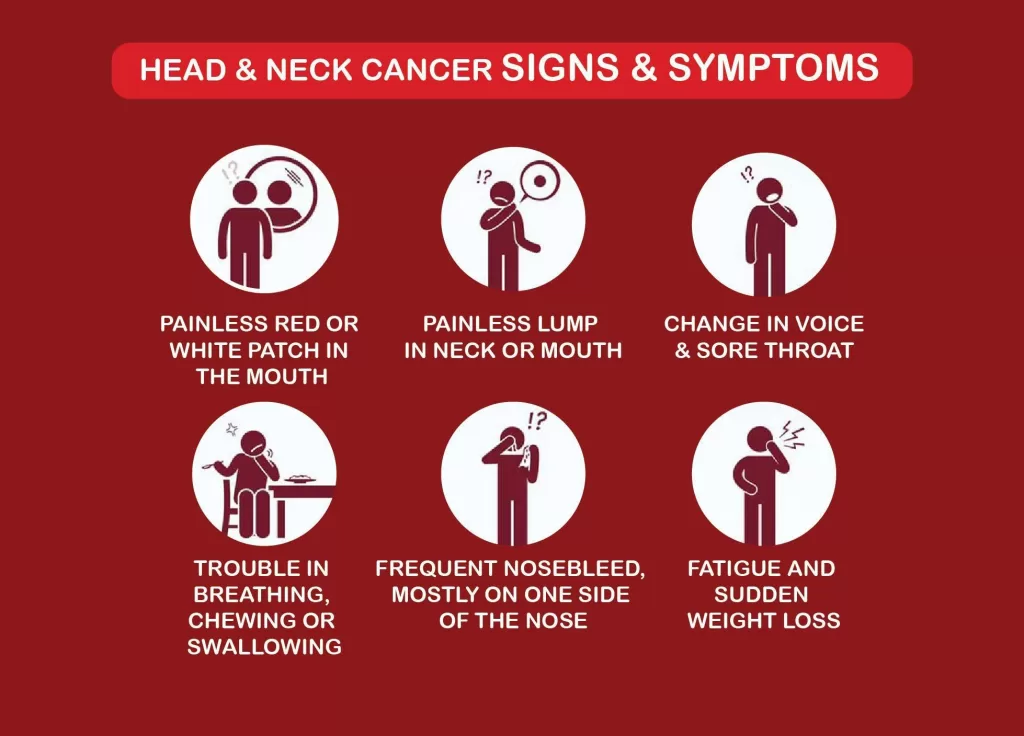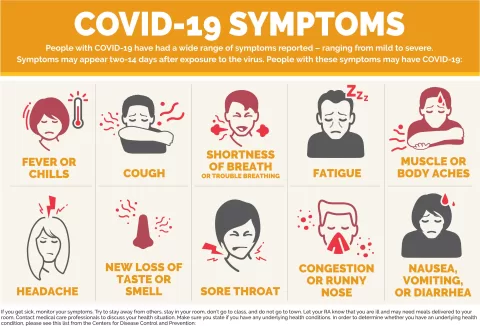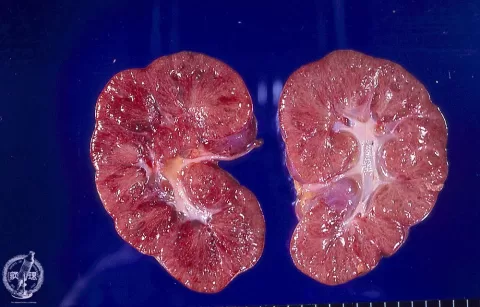The early signs of head and neck cancer can often be subtle, yet they are crucial indicators for timely intervention. Identifying symptoms such as lumps in the neck, persistent hoarseness, or changes in the voice not only fosters awareness but also emphasizes the importance of early detection of cancer. April is recognized as Head and Neck Cancer Awareness Month, serving as a powerful reminder for individuals to stay informed about potential head and neck cancer symptoms. By being vigilant and understanding these early signs, individuals can improve their chances of successful treatment and recovery. Regular check-ups and consultations with healthcare professionals can make a significant difference in outcomes, highlighting why awareness and knowledge are key in the fight against this formidable disease.
Recognizing the potential indicators of oral and throat cancers is essential for fostering public health awareness. The development of tumors in the regions around the mouth, throat, and voice box can lead to a variety of alarming signs, such as swelling or lumps in the neck, and notable changes to the voice. This critical information is essential for understanding the broader spectrum of head and neck oncology, enhancing the discussion around cancer prevention and early detection strategies. Comprehensive awareness campaigns can help educate the public on the importance of monitoring their health and acting promptly upon noticing any unusual signs. This proactive approach not only aids in timely diagnosis but may also contribute to better survival rates.
Understanding Early Signs of Head and Neck Cancer
Early signs of head and neck cancer can often be subtle and easily overlooked, making awareness crucial for timely diagnosis. Patients may initially notice lumps in the neck, which might indicate the presence of cancerous tumors that have spread to lymph nodes, a common occurrence in head and neck cancers. This lump can feel firm or swollen, and it may remain painless during the early stages. Other early symptoms include persistent changes in voice, such as hoarseness, which can arise if tumors develop near the larynx, the area responsible for voice production. Recognizing these symptoms early is vital, as it allows for prompt medical intervention that can significantly improve patient outcomes.
Additionally, changes in the oral cavity, such as sores or lesions that don’t heal within a few weeks, can also be indicative of head and neck cancers. These symptoms are often accompanied by other issues like difficulty swallowing, persistent sore throat, or even unexplained weight loss. Understanding the array of symptoms associated with these cancers can empower individuals to seek medical advice sooner, improving the chances of early detection and successful treatment.
The diversity of symptoms associated with head and neck cancers highlights the importance of awareness and education. Many individuals may dismiss warning signs like persistent hoarseness or a lump in the neck as minor inconveniences, but these can be critical indicators of more serious health issues. According to Dr. Lillian Siu, recognizing these early signs is essential, as early detection plays a significant role in determining treatment effectiveness and overall prognosis. Public awareness campaigns, especially during Head and Neck Cancer Awareness Month in April, serve to educate the community about these symptoms, fostering an environment where individuals feel empowered to seek evaluation by healthcare professionals.
The Importance of Head and Neck Cancer Awareness
Head and neck cancer awareness is essential not only for early detection but also for understanding risk factors associated with these types of cancers. Awareness campaigns play a crucial role in educating individuals about the symptoms, potential causes, and preventive measures they can take to minimize their risk. For instance, factors such as tobacco use, excessive alcohol consumption, and certain viral infections like HPV have been linked to the development of head and neck cancers. By increasing knowledge about these risk factors, individuals can make informed choices and adopt healthier lifestyles that may reduce their chances of developing cancer.
Moreover, raising awareness about head and neck cancer symptoms can lead to earlier diagnosis and treatment, significantly affecting survival rates. As noted in the key takeaways, head and neck cancers account for a small percentage of cancer diagnoses but have a substantial impact on mortality. Community outreach initiatives, educational seminars, and health screenings can foster greater public consciousness, ultimately facilitating earlier medical consultations and the possibility of life-saving interventions.
In addition to enhancing awareness, community support plays a vital role in the fight against head and neck cancer. Initiatives that promote discussions surrounding the disease can help eliminate stigma and encourage individuals to seek help when they notice concerning symptoms. Fundraising efforts for research and patient support services can also contribute to better treatment options and resources for those affected. Collaborative partnerships with local healthcare providers and organizations can amplify these efforts, ensuring that information about early signs of head and neck cancer reaches a wider audience. As we observe Head and Neck Cancer Awareness Month, it is crucial to remember that awareness, education, and community action can pave the way for improved health outcomes.
Recognizing Lumps in the Neck: A Key Symptom
Lumps in the neck are one of the most commonly reported symptoms associated with head and neck cancer, often indicating underlying malignancies. These lumps may be the result of metastatic cancer cells having spread to the lymph nodes from a primary tumor in regions such as the throat or oral cavity. Patients may notice these lumps while grooming or during regular self-examinations. Understanding that persistent or growing lumps in the neck warrant medical evaluation is crucial, as timely investigation can lead to early diagnosis and intervention, ultimately improving the prognosis for patients.
The nature of the lump can vary, ranging from small, hard masses to larger swellings that may or may not be painful. It’s important for individuals to monitor these changes closely and seek medical advice if they experience a lump that lasts for more than two weeks. While there can be many benign causes for neck lumps, including infections or reactive lymphadenopathy, the possibility of cancer should always be on the differential diagnosis list, especially in individuals with risk factors for head and neck cancer.
In addition to lumps, other accompanying symptoms such as persistent sore throat, difficulty swallowing, or voice changes may also signal the potential presence of cancer. Regular consultations with healthcare professionals and timely check-ups can lead to the discovery of early signs and symptoms, improving the likelihood of successful treatment. Furthermore, education surrounding these symptoms is essential in promoting self-advocacy among patients. Those who are aware of the importance of recognizing lumps in the neck and acting upon them promptly can significantly impact their health outcomes and quality of life.
Hoarseness: An Important Indicator of Cancer
Hoarseness, defined as a change in voice quality often characterized by a rough or strained voice, can be one of the early indicators of head and neck cancer, particularly when caused by tumors in the larynx or surrounding areas. The development of hoarseness is relevant as it may suggest that a lesion is altering the normal function of the vocal cords. For individuals experiencing persistent hoarseness for more than two weeks, it is essential to consult a healthcare provider, as this could signify serious underlying conditions including cancer.
Notably, hoarseness accompanied by additional symptoms, such as difficulty breathing or swallowing, can further indicate significant issues requiring immediate medical evaluation. It’s essential for patients to understand that while hoarseness can result from various benign causes, including allergies or respiratory infections, its persistence warrants a thorough examination to rule out malignancies.
Moreover, education about hoarseness and its potential link to head and neck cancer is critical, especially among high-risk groups. Individuals with a history of smoking, excessive alcohol consumption, or prior exposure to particular toxic compounds should be particularly vigilant about changes in their voice. By raising awareness and encouraging people to pay attention to their vocal health, healthcare professionals can foster early detection opportunities. Ultimately, timely recognition of hoarseness as a possible warning sign can lead to earlier interventions and better management of head and neck cancers.
The Role of Early Detection in Cancer Treatment
Early detection of cancer, including head and neck cancers, is a fundamental aspect of effective treatment and management. Identifying cancer in its initial stages can significantly increase the chance of successful treatment outcomes. For head and neck cancer, this can involve various diagnostic procedures, such as imaging tests, biopsies, or endoscopies, aimed at confirming the presence of malignancy as soon as possible. As emphasized by experts including Dr. Siu, early intervention is crucial in improving survival rates and minimizing treatment-related complications.
Additionally, patients who are proactive in recognizing symptoms and seeking timely medical assistance tend to have more favorable prognoses. Involvement in screening programs and routine health check-ups is an essential part of maintaining health awareness, particularly for individuals at higher risk of developing head and neck cancers. Understanding that early detection can lead to less aggressive treatment options is vital for encouraging individuals to prioritize their health.
Healthcare providers play a pivotal role in advocating for early detection and patient education regarding head and neck cancer symptoms. Initiatives that focus on training professionals to recognize symptoms early can significantly affect patient outcomes. Moreover, increasing access to regular screenings and educational resources for at-risk populations can facilitate earlier diagnosis. The multidisciplinary approach in patient care—not only focusing on oncologists but also integrating primary care physicians, dentists, and other specialists—can enhance early detection efforts. Therefore, fostering an environment where health discussions about early signs of head and neck cancers become common can result in lives saved.
Promoting Community Support for Cancer Awareness
Community support plays a vital role in enhancing awareness for both head and neck cancer and promoting early detection practices. Engaging local organizations, healthcare networks, and educational institutions can facilitate comprehensive outreach initiatives aimed at informing the public about the symptoms and risk factors associated with head and neck cancer. By creating platforms for individuals to share their experiences and knowledge about the disease, communities can foster a supportive environment that encourages early detection and mutual support for those affected.
Events such as health fairs, awareness month campaigns, and free screening programs can serve to connect individuals with healthcare providers and vital information. Collaborating with survivors of head and neck cancer to share their journeys can also instill hope and knowledge for those who may be navigating similar experiences. Amplifying community voices in these discussions can lead to a reduction in stigma surrounding cancer and empower individuals to seek help when they recognize concerning symptoms.
Furthermore, community-driven fundraising initiatives can significantly impact the resources available for research and patient support. Collecting funds can fuel new research into treatment advancements and innovative early detection methods that could save lives. There is a need for continuous education and awareness within communities to ensure that misconceptions about head and neck cancer are dispelled. The collaborative efforts of all stakeholders, including patients, healthcare professionals, and community organizations, will enhance overall awareness and lead to improved outcomes for individuals affected by head and neck cancers.
The Connection Between Lifestyle Choices and Cancer Risk
Lifestyle choices play a significant role in the risk of developing head and neck cancers, and raising awareness about this connection can help individuals make informed decisions. Factors such as tobacco use, heavy alcohol consumption, poor oral hygiene, and a diet low in fruits and vegetables are linked to an increased risk of these cancers. By promoting healthy lifestyle changes, communities can help reduce the prevalence of risk factors associated with head and neck cancer, potentially lowering the incidence of the disease.
Moreover, understanding how certain behaviors impact cancer risk can empower individuals, encouraging them to seek lifestyle modifications that can positively influence their health. Programs that educate individuals about the importance of quitting smoking, limiting alcohol intake, and maintaining a balanced diet can be instrumental in reducing cancer risk. As individuals adopt healthier habits, the collective impact can significantly decrease the likelihood of developing head and neck cancers, ultimately benefiting public health.
Additionally, regular dental check-ups and oral health practices, such as brushing and flossing, contribute to early detection of potential cancers. Dentists often serve as the first line of defense in identifying abnormalities in the oral cavity that could signify cancer. By promoting oral health awareness and encouraging regular visits to dental professionals, individuals can be part of a proactive approach to cancer prevention. Furthermore, health education campaigns stressing the significance of a balanced diet rich in antioxidants and vitamins can support the body’s ability to combat cancerous changes, further emphasizing the link between lifestyle choices and overall cancer risk.
Frequently Asked Questions
What are the early signs of head and neck cancer?
Early signs of head and neck cancer can include persistent lumps in the neck, difficulty swallowing, and noticeable changes in voice, such as hoarseness. Patients may also experience oral abnormalities, including sores that do not heal or uncomfortable swelling. Recognizing these symptoms early can lead to timely medical intervention.
How can hoarseness indicate head and neck cancer?
Hoarseness, or a persistent change in voice, can be an early symptom of head and neck cancer, particularly if it lasts more than two weeks. This change may arise from tumors affecting the larynx (voice box), leading to voice alterations. If you experience unexplained hoarseness, it’s essential to consult a healthcare professional for evaluation.
What is the significance of lumps in the neck in relation to head and neck cancer?
Lumps in the neck are often one of the first noticeable signs of head and neck cancer. These lumps may indicate that cancer has spread from the primary tumor site to nearby lymph nodes. If you discover a lump in your neck that persists, it is crucial to seek medical advice promptly for further investigation.
How can I raise awareness about head and neck cancer symptoms?
Raising awareness about head and neck cancer symptoms involves educating others about the risks and early signs, such as neck lumps and hoarseness. You can participate in Head and Neck Cancer Awareness Month in April by sharing information on social media, organizing supportive events, and encouraging routine checkups that include screenings for individuals at high risk.
When should I seek medical advice for potential head and neck cancer symptoms?
You should seek medical advice if you notice persistent symptoms associated with head and neck cancer, such as a lump in the neck, chronic hoarseness, painful swallowing, or any changes in your oral cavity that last more than two weeks. Early detection significantly improves treatment outcomes.
What are common lifestyle risk factors for head and neck cancer?
Common lifestyle risk factors for head and neck cancer include tobacco use, excessive alcohol consumption, and human papillomavirus (HPV) infection. Being aware of these factors can help individuals reduce their risk and remain vigilant for early signs of head and neck cancer.
What is the importance of early detection of head and neck cancer?
Early detection of head and neck cancer is crucial as it significantly improves treatment effectiveness and patient outcomes. Recognizing early signs and symptoms, such as hoarseness, neck lumps, and oral lesions, can lead to prompt medical attention and better survival rates.
What should I do if I experience changes in my voice?
If you experience persistent changes in your voice, such as hoarseness, lasting more than two weeks, it’s important to consult a healthcare professional. They can evaluate your symptoms, perform necessary examinations, and determine whether further testing is needed to rule out head and neck cancer or other conditions.
| Key Point | Details |
|---|---|
| Prevalence | Head and neck cancers represent 4% of cancer cases in the U.S. |
| Symptoms | Common symptoms include neck lumps, voice changes, and oral abnormalities. |
| Importance of Early Detection | Recognizing symptoms early is crucial for timely intervention. |
| Awareness Month | April is recognized as Head and Neck Cancer Awareness Month. |
| Statistics | In 2024, approximately 71,110 diagnosed and 16,110 fatalities due to head and neck cancers. |
| Medical Expert | Dr. Lillian Siu emphasized understanding risk factors and recognizing symptoms. |
Summary
Early signs of head and neck cancer can manifest in various ways including neck lumps, changes in voice, and oral abnormalities. Understanding these signs is crucial due to the significant prevalence of head and neck cancer, which represents about 4% of all cancer cases in the U.S. Enhanced awareness and timely medical intervention can lead to improved outcomes for patients. As we observe April as Head and Neck Cancer Awareness Month, it is essential to educate ourselves about these early symptoms and act promptly when they arise.
The content provided on this blog (e.g., symptom descriptions, health tips, or general advice) is for informational purposes only and is not a substitute for professional medical advice, diagnosis, or treatment. Always seek the guidance of your physician or other qualified healthcare provider with any questions you may have regarding a medical condition. Never disregard professional medical advice or delay seeking it because of something you have read on this website. If you believe you may have a medical emergency, call your doctor or emergency services immediately. Reliance on any information provided by this blog is solely at your own risk.








